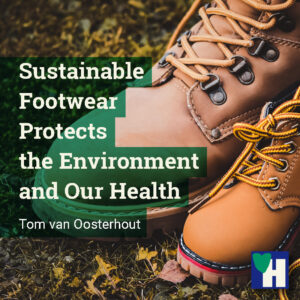
The best sustainable footwear is no footwear. Don’t think this is not possible. There is a huge movement out there of people who walk barefoot all day. Barefoot is not without risks, but in general, it’s better for your feet.
However, many of us wear shoes all day. By custom, or because we have to.
Buying shoes is always a challenge. What to look out for? What’s best for my feet? Do the shoes also support the rest of my body? What to wear in which season?
All very important questions. In this article, I would like to add another, and for most of us new, perspective: the sustainability of footwear.
Some of the links are affiliate links. As an affiliate associate, we earn a commission when you purchase any of the products offered through the shared links at no extra cost for you. This helps us maintain this website.
Table of contents
What is sustainable footwear?
Footwear is sustainable when shoe materials, shoe design, shoe manufacturing, and distribution are profitable to the environment, the laborers, the industry, and the consumers and when the footwear can be used for a reasonable period of time (at least 3 years, depending on the degree of use).
Quality shoes
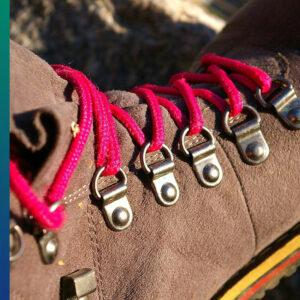
Quality shoes are an investment. I remember perfectly well that when I was an adolescent, I needed new shoes every year.
In those days, I always walked, as I do now. But then I never made the connection between cheap trendy shoes and my incessant walking.
As soon as I earned enough money to buy quality shoes, the shoes lasted at least three to five years. Depending on the amount of walking and the terrain.
For the past 3 decades, I have used specific boots for hiking. I put them on when I intend or expect to walk considerable distances. High-quality hiking boots are expensive though.
Barefoot
A couple of years ago we stayed in an apartment only a few steps from the Mediterranean. On a very sunny, but not too warm, day we went looking for a coastal cave.
The path to the cave was rough and at times steep. We were not used to such terrain and made only slow progress. Halfway through the trail, we were overtaken by a family of four. Father, mother, and a girl and boy at the age of 10 or 12. To our surprise, they were all barefoot.
Of course, barefoot is the best sustainable footwear ever.

However, we’ve come a long way from promoting barefoot as the best sustainable footwear ever. Even in the 20th-century female peasants and slaves in Russia and Ukraine were compelled to walk barefoot as an expression of their social status.
And until this very day in many countries prisoners have to remain barefoot all day.
Those who have always walked barefoot do not suffer from foot ailments such as bunions (malformation of the connection between the big toe and the foot) or corns (cone-shaped inwardly growing piece of dead skin – callus) or flat feet.
Children who normally go barefoot have stronger and more flexible feet. Their mobility is usually better and they have fewer disfigurements, such as flat feet.
In short, walking barefoot is healthier than wearing shoes.
5 Healthy footwear tips
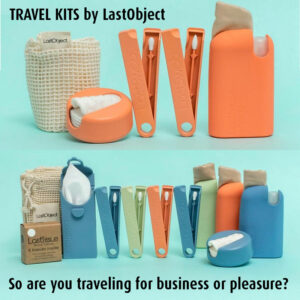
What shoes to wear? Pose this question on the internet and you will get 1,5 million answers on which shoe fits with what dress or type of pants.
When you ask the question ‘what shoes to wear to remain healthy’, ‘oops’ no answer is forthcoming. Fortunately, the words ‘healthy footwear’ are helpful.
In summary, healthy footwear fits, gives comfort, and is made of natural materials. Wear shoes that fit the circumstances. Regularly change the type of shoes in one day. Do not wear shoes when possible.
More specifically, it must be easy to remember the following 5 healthy footwear tips when you go and buy new shoes.
Well balanced feet function
In general, the width and depth of the shoe are important. When we try on a shoe, we must actually feel that our feet can function properly.
This means that the shoes are comfortable to walk in. We must be certain that the shoes support the balance of our bodies.
We need to be confident that we’re able to move around with normal effort and that we are not at risk of falling.
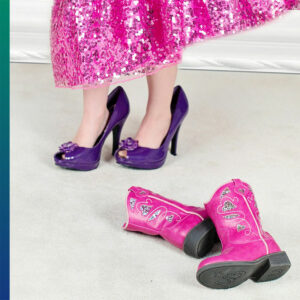
Our shoes must not slip on our feet. That’s a sure signal that we’re wearing the wrong shoes.
A proper toe box
The toe box is the nose part of the shoe. There must be at least a space of 6 mm between the largest toe and the front side of the shoe.
The toe box also has to be wide enough to allow for the proper functioning of the foot.
Strong and stable sole
The sole is important because it has to carry the full weight of your body. Preferably, the sole is made as one block and has a crosshatched profile across the entire foot.
The sole must be strong and stable. It must provide so-called medial-lateral stability. This means that the sole must keep us firmly with both feet on the ground. The shoes should not be able to twist in the middle when you firmly handle them.
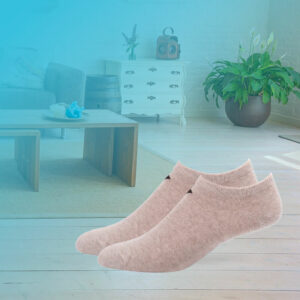
At the same time, the front part of the sole must be able to flex simultaneously with the movements of the feet when walking.
In contrast, the heel must be a sturdy block and more or less 25 mm high. High heels are extremely bad for feet.
In short, the sole must give excellent shoe-ground traction.
Strong and flexible upper material
The shoe’s upper material must also be able to flex and reshape with the movements of the foot when walking.
And the material must be adjustable with laces or buckles. This is important because our feet are not always the same size. When warm they are thicker.
Healthy in-shoe climate
The shoe must be able to produce a healthy in-shoe climate. In the heat, the shoe must keep the feet cool. In the cold, the feet must remain comfortably warm.
Moist must not be able to enter the shoe. Although the dampness of the feet must be able to be captured by the shoes’ material. This means that a certain amount of air must be able to enter and leave when wearing the shoe.
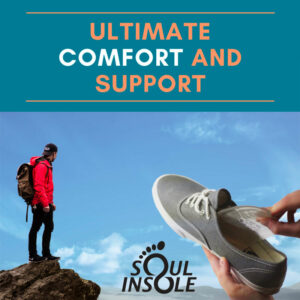
Sustainable footwear
Shoes used to be made of wood, leather, hemp, or esparto (a tall type of grass). At present most shoes are made of rubber, plastic, and other synthetic materials.
These new materials are not sustainable. To degrade modern mass-produced shoes, made of rubber, plastics, and other synthetic materials, takes more than 1000 years in a landfill.
Moreover, rubber, plastic, and synthetic shoes often do not comply with the 5 healthy footwear tips.
Related: Are there Easy Ways to Reduce Plastic Waste? LastObject Knows.
Wooden shoes or clogs
For ages, wood has been one of the most important raw materials to produce shoes. Who doesn’t know those strong big yellow Dutch wooden shoes called klompen?
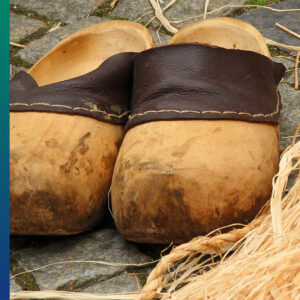
You can wear them with or without socks. Although I must say that either way, it takes some effort to get used to wearing klompen. However, once your feet settle themselves to the sturdy wood, you’ll certainly enjoy them.
In Sweden, the träskor wooden shoe is very famous. Even though only the sole is made of wood and the upper layer is leather. It’s also open at the back. They have been very popular among medical professionals in hospitals.
The Japanese geta wooden shoe is also very well known. It is one of the most simple wooden shoes. It’s a piece of wood that supports the feet and underneath two small pieces to walk on. They resemble flip-flops but are way healthier and far more sustainable.
Leather shoes
The oldest leather shoe discovered so far is from around 3500 BC. The shoes of the famous Ötzi the Iceman, date back to 3300 BC and are really sophisticated.
The sole is made of bearskin and the side panels of deerskin. Sole and side panels are stitched together with a bark string.
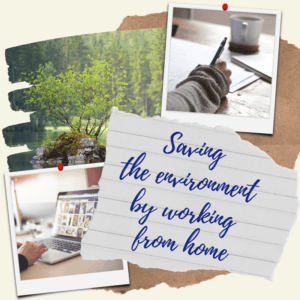
In most quality shoe shops you can usually buy a substantial variety of leather shoes. When you’re prepared to invest in healthy feet and a healthy body, there is an abundant choice.
But even when you buy leather shoes, always follow the 5 healthy footwear tips.
Hemp (canvas) shoes
Industrial hemp is a variety of the cannabis sativa plant. Bamboo and hemp are the fastest-growing plants on earth.
When refined, hemp is used to make paper, rope, textiles, biodegradable plastics, paint, insulation, and food for humans and animals.
More and more hemp is also used in the production of shoes. Because hemp can be refined that easily, making it strong and versatile, it is also used for the sole of shoes.
Espadrilles
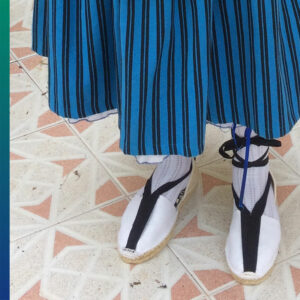
As early as 6000-5000 BC, people in southern Spain wore espadrilles. Espadrilles are made of esparto grass, more specifically the stipa tenacissima type of esparto grass. Called atocha over here.
Espadrilles are the former peasant footwear of southern Spain. To make the fiber to weave the espadrilles the freshly cut esparto leaves have to soak in water for a month.
After that, they need to be dried and crushed. This makes the fiber stronger and easier to weave. The weaving is done by hand and is still a traditional craft in southern Spain, where an ‘esparto culture’ exists.
Sustainable footwear: enough choice
It is obvious that there is a substantial choice in sustainable footwear. There are many arguments to ban rubber, plastic, and synthetically made shoes entirely from the market.
Such a ban would greatly improve the environment and support the prevention of manmade climate change. Moreover, it would also benefit our health.
Before such a ban is effected, we can make a choice ourselves. Starting from today. Let’s only buy sustainable shoes.
What type of shoes do you prefer to wear? Please tell us in the comment box.

You should choose the right kind of work footwear for your occupation. Occupational Safety and Health Standards are a must while choosing footwear for yourself. It’s true that these standards sometimes don’t deliver tailormade footwear. Perhaps this is because many employers and employees underestimate the relationship between good health and healthy footwear. Tailormade is often so expensive. However, I agree tailormade is an investment. The return on this investment is in a good health and being able to stay at work.
Hi Pamela,
Sometimes when I visit shops or supermarkets, there are female and male employees standing behind the registers all day. I hope they wear proper footwear.
Moreover, because most of them are still very young. When I was young I never paid much attention to what I was doing and the impact of that on my future health.
It’s never too early to become aware of the importance of sustainable footwear. And not just because it’s good for your personal health. It is also good for the planet and enables you to work longer.
Thank you for your comment. Stay safe, stay healthy.
Regards,
Tom
I have four pairs of TOMS that look brand new after many, many years of walks around the city or work commute. I try to stay away from fast fashion as much as possible and since discovering vintage stores it has been easier and easier. So many good choices and I know for a fact I won’t be wearing the same thing as the woman next to me.
Hi Gianna,
You’re right, being frugal when it comes to clothes and footwear, will always separate you from the next person.
The challenge is of course, how frugality works out for your health. Being sustainable is very important for us, but we always try to take our health concerns into account.
Anyway, we noticed that paying more for clothes and footwear, and at the same time paying attention to their being sustainable, in the end, pays off. We can enjoy our stuff longer and pay less.
Never visited vintage stores, however. Must try them someday.
Thank you for your comment.
Regards,
Tom